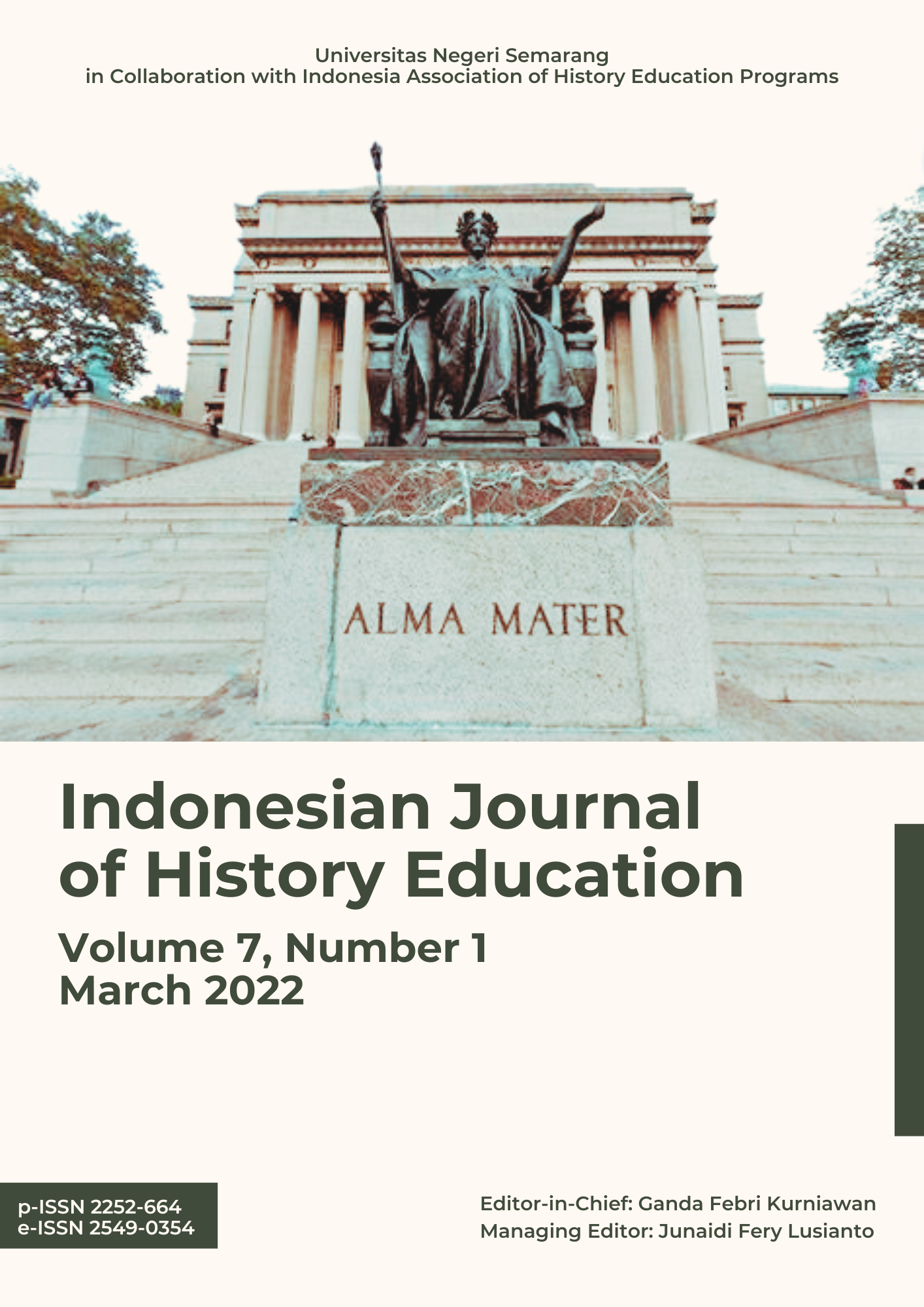Development of Lasem War Teaching Materials in Form Booklet for Learning Local History at SMA Negeri 1 Lasem
Abstract
This study aimed to describe the needs of teachers and students in learning local history at SMAN 1 Lasem, knowing the development of regional history teaching materials, and understanding the effectiveness of the teaching materials developed. The method used in this study was the research and development method with the pretest-posttest control group design. Data collection techniques used in this study include observation techniques, interviews, questionnaires, document studies, and tests. The results showed that the development of teaching materials in the form of booklets on the local history of the War of Lasem was tailored to the needs of teachers and students and relevant sources. The feasibility of booklet teaching material was seen from the results of validation by material experts in stage I (82.04%) and stage II (84.49%) and media experts in stage I (75.56%) and stage II (78.75%) and teacher responses (87.5%) and students (88%) so that it can be concluded that the booklet-shaped teaching material is suitable for use in learning local history in SMAN 1 Lasem. Using teaching materials in the form of booklets can improve student learning outcomes. The experimental class student learning outcomes (84.6538) were better than the control (78.3571). Therefore, it can be concluded that the teaching materials in booklets are effective for teaching materials used in learning local history in SMAN 1 Lasem.
References
Amin, S. (2011). Pewarisan Nilai Sejarah Lokal Melalui Pembelajaran Sejarah Jalur Formal Dan Informal Pada Siswa SMA di Kudus Kulon. Dalam Paramita Historical Studies Journal Vol. 21 No. 1. Hal. 105–115.
Aziz, A. (2020). Persekutuan muslim jawa dan etnis tionghoa melawan Belanda dalam perang sabil di lasem (1750 M) (Doctoral dissertation, UIN SUNAN KALIJAGA YOGYAKARTA).
DI LASEM, A. L. Z. Perspektif Sejarah dan Budaya.
Hadi, S. (2018). Internalisasi nilai-nilai islam wasathiyah dan wawasan kebangsaan di kalangan pelajar santi di lasem. Istiqro, 16(01), 79-102.
Hadi, S. (2020). Lasem: Harmoni dan Kontestasi Masyarakat Bineka. ISLAM NUSANTARA: Journal for the Study of Islamic History and Culture, 1(1), 163–208.
Harry, H., Marta, R. F., & Briandana, R. (2021). Memetakan tautan budaya Lasem melalui dokumenter Net. biro Jawa Tengah dan MetroTVNews. ProTVF, 5(2), 227-246.
Jaeni, M. (2021). Sang Pecinta Ilmu: Simbah KH. Zainuddin Lasem (Pendiri Madrasah An-Nashriyyah). Penerbit NEM.
Kurniyawan, C. O. (2020). MUSEUM SEJARAH PERANG KUNING di LASEM. eDimensi Arsitektur Petra, 8(1), 761-768.
Lapian, A. B. (2009). Orang laut, bajak laut, raja laut: sejarah kawasan Laut Sulawesi abad XIX. Jakarta: Komunitas Bambu.
Lestari, S. N., & Wiratama, N. S. (2018). Dari Opium Hingga Batik: Lasem Dalam “Kuasa” Tionghoa Abad XIX-XX. Patra Widya: Seri Penerbitan Penelitian Sejarah dan Budaya., 19(3), 253-270.
Merdeka, S. (2013). Perang Lasem Berawal dari Seruan Jumatan. Suara Merdeka, Rabu, 31.
Mintarti. (2001). Efektivitas Buklet Makjan Sebagai Media Belajar Untuk Meningkatkan Perilaku Berusa Bagi Pedagang Makanan Jajanan. Tesis. Bogor: Intitut Teknologi Bandung.
MUAWANAH, S. (2015). Perang stigma antara siswa IPA/IPS di MAN Lasem. Paradigma, 3(1).
Nafiin, M. I. (2018). Perang Lasem Jawa Tengah Tahun 1750-1828 M (Doctoral dissertation, UIN Sunan Kalijaga Yogyakarta).
Purnamasari, I. dan Wasino. (2011). Pengembangan Model Pembelajaran Sejarah Berbasis Situs Sejarah Lokal di SMA Negeri Kabupaten Temanggung. Dalam Paramita Historical Studies Journal Vol. 21 No. 2. Hal. 202-212.
Rengganis, R. (2013). Sosok di balik Perang. RAIH ASA SUKSES.
Riyanto, S., Mochtar, A. S., Alifah, A., Taniardi, P. N., & Priswanto, H. (2020). Lasem dalam rona sejarah Nusantara: sebuah kajian arkeologis (pp. xiv-100). Balai Arkeologi Provinsi Daerah Istimewa Yogyakarta.
Satmoko, S. dan Harini T.A. (2006). Pengaruh Bahasa Booklet Pada Peningkatan Pengetahuan Peternak Sapi Perah Tentang Inseminasi Buatan Di Kelurahan Nongkosawit, Kecamatan Gunungpati Kota Semarang. Dalam Jurnal Penyuluhan Vol. 2. No. 2.
Septyana, N. H. (2012). Sejarah Perkembangan Klenteng Gie Yong Bio di Lasem dan Pengaruhnya Masyarakat 1967–1998. Journal of Indonesian History, 1(2).
Sugiyono. (2015). Metode Penelitian dan Pengembangan Research and Development. Bandung: Alfabeta.
Tanjung, S. (2015). Pengaruh Media Pembelajaran dan Gaya Kognitif Terhadap Hasil Belajar Sejarah. Dalam Paramita Historica Studies Journal Vol. 25 No. 2. Hal. 261–271.
Unjiya, M. A. (2014). Lasem, Negeri Dampo Awang: Sejarah yang Terlupakan. Sleman: Salma Idea.
Widja, I. G. (1989). Sejarah Lokal Suatu Perspektf dalam Pengajaran Sejarah. Jakarta: Pengembangan Lembaga Pendidikan Tenaga Kependidikan.
Yusuf, M., Saraswati, U., & Ahmad, T. A. (2019). Pengembangan Bahan Ajar Perang Lasem Dalam Bentuk Booklet Untuk Pembelajaran Sejarah Lokal Di Sma Negeri 1 Lasem. Indonesian Journal of History Education, 7(1), 50-58.
Copyright (c) 2022 Indonesian Journal of History Education

This work is licensed under a Creative Commons Attribution 4.0 International License.
Copyright Notice
An author who publishes in the Jurnal Indonesian Journal of History Education agrees to the following terms:
- Author retains the copyright and grants the journal the right of first publication of the work simultaneously licensed under the Creative Commons Attribution-ShareAlike 4.0 License that allows others to share the work with an acknowledgement of the work's authorship and initial publication in this journal
- Author is able to enter into separate, additional contractual arrangements for the non-exclusive distribution of the journal's published version of the work (e.g., post it to an institutional repository or publish it in a book) with the acknowledgement of its initial publication in this journal.
- Author is permitted and encouraged to post his/her work online (e.g., in institutional repositories or on their website) prior to and during the submission process, as it can lead to productive exchanges, as well as earlier and greater citation of the published work (See The Effect of Open Access).
Read more about the Creative Commons Attribution-ShareAlike 4.0 Licence here: https://creativecommons.org/licenses/by-sa/4.0/.




